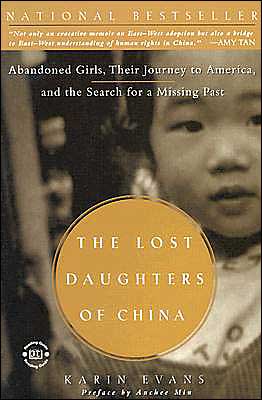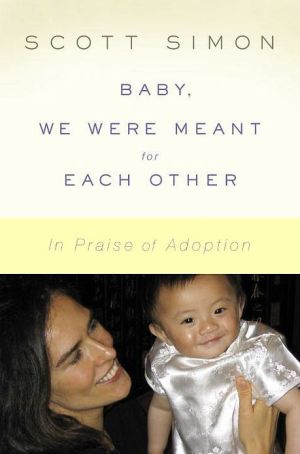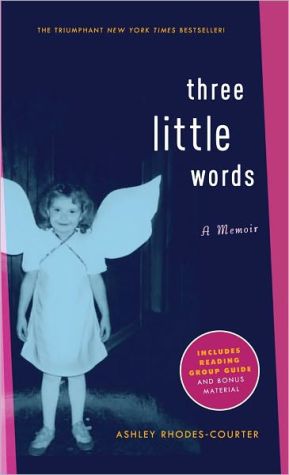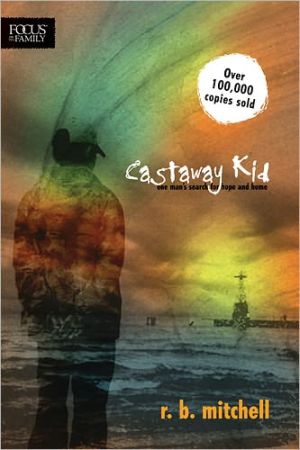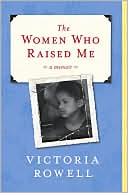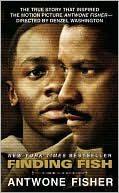The Lost Daughters of China: Abandoned Girls, Their Journey to America, and the Search for a Missing Past
The memoir of an American mother of an adopted Chinese baby girl is a cultural history of the events that led to the controversial 1980 one-child policy in China and the subsequent generation-long abandonment of Chinese daughters to American families. Reprint. About the Author Karin Evans, a former editor at Outside magazine, senior editor for Health magazine, and senior editor for the San Francisco Examiner's Sunday magazine, was a founding editor of Rocky Mountain Magazine....
Search in google:
"Breathtaking-an unforgettable story."-Iris Chang, author of The Rape of NankingIn 1997 journalist Karin Evans walked into an orphanage in southern China and met her new daughter, a beautiful one-year-old baby girl. In this fateful moment Evans became part of a profound, increasingly common human drama that links abandoned Chinese girls with foreigners who have traveled many miles to complete their families. At once a compelling personal narrative and an evocative portrait of contemporary China, The Lost Daughters of China has also served as an invaluable guide for thousands of readers as they navigated the process of adopting from China. However, much has changed in terms of the Chinese government's policies on adoption since this book was originally published and in this revised and updated edition Evans addresses these developments. Also new to this edition is a riveting chapter in which she describes her return to China in 2000 to adopt her second daughter who was nearly three at the time. Many of the first girls to be adopted from China are now in the teens (China only opened its doors to adoption in the 1990s), and this edition includes accounts of their experiences growing up in the US and, in some cases, of returning to China in search of their roots. Illuminating the real-life stories behind the statistics, The Lost Daughters of China is an unforgettable account of the red thread that winds form China's orphanages to loving families around the globe.
The Lost Daughters of China\ Abandoned Girls, Their Journey to America, and the Search for a Missing Past \ \ By Karin Evans \ Jeremy P. Tarcher\ Copyright ©2001 Karin Evans\ All right reserved.\ ISBN: 1585421170 \ \ \ \ \ Chapter One\ \ \ Journey to the East\ \ \ Moon thin as water\ And watery candlelight\ Shine upon China\ A sleeping silkworm\ Exhaling a long long thread of silk\ On a nine-hundred and sixty thousand\ square miles\ Mulberry Leaf.\ —Li Xiaoyu\ \ \ In the Pearl River Delta of southern China, the land is criss-crossed by water. Rivers, like long fingers, reach deep into the landscape from the South China Sea, and along their banks, fertile soil would seem to promise paradise. The climate is subtropical and mild, rainfall is plentiful, and the fields are patch-worked in muted tones of green. Farmers tend their rice in rolling terraces. Water buffalo stand placidly in the fields. Where there aren't rice paddies, plots of pole beans and elephant-leafed taro spring from the ground. Sugarcane grows in profusion, and there are mulberry trees, harboring billions of silkworms.\ Long ago, these rivers helped open this part of China to the world. First Romans, then Arabs, then European missionaries and merchants, all ventured upriver. By thelate eighteenth century, the British had established a foothold with the East India Company, seeking China's wares. In the place they called Canton, British merchants put up their warehouses, offering opium in exchange for Chinese silk, porcelain, and tea.\ Today the provincial capital is not called Canton, as it was in the old days of Western imperialism, but Guangzhou. Foreigners still are drawn here, some by the welcoming entrepreneurial atmosphere, others for reasons of the heart. Waterways still spiderweb the delta in this part of Guangdong province, but the waters are grayer now and the air is hazier. And there are other rivers here, too—cement superhighways, the first built in 1989—along which flow locally made goods, imported ideas, and an on-the-move populace. Freeways, some privately financed by business tycoons, link the now-sprawling cities of the Pearl River Delta with one another, with bustling new trade zones, and with enterprising Hong Kong to the south.\ My husband, Mark, and I were rolling along one of these highways on a mild fall day in 1997, viewing the changing landscape of China through a tour bus window. Just a few years before, it had taken seven hours to travel south from Guangzhou to a mid-sized southern Chinese city called Jiangmen, where we were headed, but the new freeway had shortened the trip to less than two.\ We sped along with the standard collection of Chinese traffic—overloaded trucks, underpowered scooters, swarms of bicycles and motorcycles, and an occasional European-made luxury car with tinted windows. Despite these modern intrusions, some of the terrain we passed through still looked ancient and serene, like a scroll painting of old China. Viewed from the bus window, a human being, small in the landscape, wearing a straw hat, stood beside a pair of yoked oxen. Rivers ran through the mist; boats motored languidly along the rivers. Here and there were old villages, made of red brick with the roofs curving gracefully toward the sky.\ When Jiangmen City came into view, it was wrapped, like most of urban China, in a cloud of haze, though less densely than Guangzhou. Traffic picked up and the bus slowed, rolling past boxy concrete structures and small factories. The road filled with increasing numbers of wobbling bicycles and skittering motorbikes. We passed a truck so full of pigs that viewed through the slats they seemed to be stacked double and triple; some looked upside down. Beside the highway, green vegetation gave way to dust, and the calm of the countryside was broken.\ I was riveted on this scenery, noting its landmarks and trying to soak in the feel of it, curious about what lay beyond the village walls we had seen, and behind the iron-grated windows we now passed. Somewhere in this landscape our daughter had been born. Whether she came into the world in the green of the countryside or the gray of the city, I didn't know. But Mark and I were on our way to meet her. Traveling toward a Chinese orphanage, we were about to become parents.\ \ \ For one who waits, A moment seems like an eternity. —Fortune cookie, 1996\ \ \ The journey that found us peering through a bus window at the landscape of southern China had begun nearly two years earlier, half a world away, when we first set foot on what turned out to be a very long paper trail. In January 1996, my husband and I walked into an international adoption agency and emerged with a thick folder of forms. We sat down and pondered a number of questions: "Please give a brief statement of your reasons for wanting to adopt a child. What is your profession? Education level? Income? If you've had experience with infertility, please provide details." We filled in the basics: One writer, one lawyer, both over forty (in my case, well past). Recently married, no children. Both previously married and divorced. Three siblings each. Good health, covered by health insurance. Pets? One aging, gentle Siberian husky and two cats. Hobbies? Cycling, gardening, reading, painting.\ Why did we want to adopt? I wrote that I'd like to share my life and love with a child and be part of that "gift of wonder" that writer Rachel Carson celebrated in her book of that title. I said that I had lost a baby years before, an infant son who had suffered a cerebral hemorrhage at birth and died at three days old. I had thought of adopting ever since, but the circumstances had never seemed right until now.\ Mark wrote that he, too, had long wanted children, but it hadn't worked out to have them. He said his hero in the father department was the lawyer Atticus Finch in Harper Lee's To Kill a Mockingbird. He described Atticus as a man who gave his children the utmost respect and loving guidance, and with great patience helped them understand and prepare for a world that could be harsh and unfair.\ We began the process of adoption with high hopes and great anxiety. I didn't need an adoption agency to tell me I was seriously out of sync when it came to starting a family. My college friends were now sending their children off to college. Yet I had this clear, certain yearning, a longing I had tried to push aside for years after my baby died, busying myself with work and various projects. I had, as one cyclist friend put it, kept my head down and my feet moving. When, after more than a few disappointments, I found myself one day with a man who also wanted to adopt a child, all my old desires woke up. I was startled by their sudden appearance and intensity.\ It took courage to call an adoption agency, to get my hopes up; to risk judgment on my worthiness at being a parent. But some door, long closed, had opened. Sunlight and possibilities filtered in. Why not? I thought.\ We had heard that China had lots of babies available for adoption, and it seemed a better idea to us to try to adopt a child who was already without parents than to try to compete with a large pool of couples in America who were vying for a diminishing number of newborns. I'd lived in Hong Kong during my first years as a journalist and I was drawn to that part of the world. Something about the land and water, the sights, sounds, and smells, the people bustling through the streets, just agreed with me. I'd felt at home.\ The adoption agency agreed that China was a good idea for us. There were numerous little girls available, the application and approval process tended to be faster than in other countries, and China was more forgiving of older parents than were some South and Central American adoption programs. Moreover, the Chinese adoption program wasn't tainted by rumors of stolen children or babies for sale, or black-market profiteers. The health of the children was generally good. China was, in fact, blessed by the relative absence of such modern ills as fetal alcohol syndrome or HIV infection. The babies could be adopted at a young age—most at a year old or younger—lessening the chances of attachment disorder, and the care in the orphanages that dealt with foreign adoption was apparently good.\ So we set forth. I comforted myself with the thought that maybe it would be better for a small orphan in China to have an older mother than no mother at all. "The Chinese respect what you are trying to do," the woman at the agency told me. Having passed our initial interview, we put down some money and walked away with our instructions. We were told the whole process would take about a year and cost around $15,000.\ We next had to apply to the United States Immigration and Naturalization Service for "advance permission to adopt a foreign orphan." That required digging up our original birth certificates, marriage certificates, and divorce decrees; and getting fingerprinted for a background check by the Federal Bureau of Investigation. We also needed a home study by a licensed social worker, required by the State of California—as well as the Chinese authorities—to certify that we were stable candidates as parents and would provide a safe and supportive environment for a child.\ Since the INS form asked the question, one or two orphans?, we requested permission to adopt two children at once; we thought it would be good for the children to have each other. But the agency said this wouldn't be possible. China didn't allow foreigners to do this—except in the rare case of twins. Evidently, they felt it would be unfair to allow foreign parents to take two children at once when many of their own people were now limited by government policy to a single child.\ It made a rough kind of sense, but then we found that once an American family adopts one child, they can adopt a second. They just have to start the entire process all over again, from start to finish, and pay a second set of fees. And the second time (until the stipulation was dropped in 1999) a family was required to adopt a child with "special needs"—some medical problem, usually correctable, that needed attention. At the time, parents under thirty-five, or who already had children living at home, were also assigned a child with special needs. But these guidelines, we soon found, could shift depending on who was working with what agency, when, and in which province.\ At the point we began, thousands of adoptive parents had gone to China before us and thousands more were waiting with us, drawn halfway across the world by a strange series of events. In the world's most populous country, babies were being found, lying alone, on a daily basis—nearly all of them girls. Some of the lost children wound up in state care. By the time Mark and I began the application process in San Francisco, many of China's institutions were filled to overflowing with abandoned baby girls, a small percentage of whom were making their way through the bureaucracy into the waiting arms of would-be parents like ourselves.\ The current wave of adoptions from China had begun as a trickle in the late 1980s. At first these arrangements were informal, individual affairs, which broke through the Chinese government's earlier reluctance to let non-Asians adopt Chinese children. A few Americans working in China managed to find abandoned or orphaned children, to more or less invent their own paperwork and work out arrangements with the various layers of government. "I'd go to the police station and cry every week," said one American woman who was living in China in the mid 1980s and wanted to adopt a little girl who'd been left at a medical clinic at five days old. Eventually, the woman convinced both the Chinese and American authorities to let her leave China with the child, but it was a struggle.\ In 1989, 201 children from China entered the United States, but the arrangements still were scattershot. Centralization came with the approval of a national adoption law, which China enacted in 1992, officially granting foreigners the right to adopt Chinese babies and setting up protocols for doing so. Soon a number of U.S. adoption agencies were working with China, including some of the veteran international groups such as Holt International Children's Services. By 1995 the number of Chinese children adopted annually by American parents was up to two thousand, by 1998, more than four thousand.\ The babies were usually between six and twelve months old by the time the necessary paperwork had been completed on both continents and the prospective parents had traveled to China to pick them up and take them home. All were the small victims, it was generally believed, of the Chinese government's rigidly enforced population control policy.\ In the United States, meanwhile, there were increasing numbers of couples with infertility problems—6 million by a 1998 count—an increasing percentage of whom were now competing for a decreasing number of American infants available for adoption. The rate at which American women relinquish their babies had declined dramatically in the past few decades. Given the availability of birth control and abortion in this country, and the number of childless people seeking healthy infants, would-be parents trying to adopt a newborn could find themselves facing tough competition, long waits, great expense (private adoption fees as high as $30,000, and more), broken agreements, and worries about the security of the legal adoption bond—fueled by a number of well-publicized cases of birth mothers attempting to take back their children. According to the Evan B. Donaldson Adoption Institute, for every person who succeeded in a domestic adoption, there were five or six others who didn't.\ So, by the 1990s a growing number of people had turned to international adoptions—in Guatemala, Chile, Paraguay, and Ecuador; in Eastern Europe and Russia; and in Asian countries including Taiwan, Thailand, Vietnam, and Korea, where there had been a long-standing adoption program dating back to the 1950s. But at the time Mark and I began our adoption process, China had the greatest numbers of infants available for adoption. Since an overwhelming majority of the would-be parents in the United States, whether they were pursuing parenthood through in-vitro fertilization or adoption, said that they preferred girls, China seemed a perfect destination for a large number of childless Americans. A few added another reason for choosing China: the absence of identifiable birth parents.\ By the late 1990s, at least a hundred agencies were involved in the business of getting Chinese children into the hands of American parents. They ranged from seasoned, large nonprofit Christian organizations to independent for-profit agencies to lone liaisons trying their luck at the baby-brokering business. There was by now a special adoption unit at the U.S. Consulate in Guangzhou, where a long line of adopting parents were interviewed each day so that their new children could be granted visas and the right to enter the United States.\ \ \ Mark and I were soon answering dozens of personal questions. (Have you ever received psychiatric or psychological treatment? Have you ever been arrested, or have you ever had an arrest record expunged? What are your plans for childcare?) We added up our assets, dug out our tax returns, asked friends to write letters of reference, requested letters of verification from our employers, and went to our doctors for the required checkups.\ Within a few months we had a folder five inches thick, stuffed with forms and reports. We began to learn how much patience, acceptance, and trust was called for. Maybe it would all work out and maybe it wouldn't. As is usual with such a process, the recitation of our histories barely scratched the surface of our lives. But we dutifully laid out our stories on paper, expressing our great desire for a little being to pour our love into and to guide in the world.\ There was no blank space on the forms for the few questions that would occur to us later as we felt our way through the bureaucratic maze: Are you ready to place the decision about whether you'll be able to have a child, and who that child will be, in the hands of strangers? Are you willing to pay hefty sums of money to people you've never met in order to make it all happen? Are you willing to open your lives to government agencies, domestic and foreign, to jump countless official hurdles, to document just about every aspect of your life, and to go through the agonies of waiting far longer than you thought, with very little assurance about anything?\ Yes, yes, and yes—as it turned out.\ We began a lengthy period of anticipation and confusion, joining hundreds of other would-be adoptive parents and becoming part of a subculture I never knew existed. We entered the world of the waiting.\ "Why China?" people began to ask. "Because a little girl is waiting for us there," I said at first. But a lighthearted answer invariably led to a more weighty inquiry. How to explain all the lost, waiting girls?\ Experts on China's lost girls frequently referred to an "epidemic" of abandonment when they talked about the problem. Babies, female babies, it seemed, were found everywhere, every day. Babies in sunlight and babies in moonlight. Babies wrapped in newspapers, babies bundled in rags, babies in baskets, babies in boxes. Boys, too, were found occasionally and taken to institutions, but they tended to be children who suffered from mental or physical handicaps, and they were in the minority, less than 10 percent at most. Just how many of these lost children were there in all? No one seemed to really know.\ \ \ I began writing letters to my as-yet-unknown daughter. All I knew at the time was that she'd be born somewhere in China, that she would wind up, for whatever reason, without a family, and that through some shuffling of destinies, our lives eventually would be woven together. At least, I hoped so. I had begun to think about her all the time.\ I found a notebook at a fair run by a group of hand bookbinders. The cover was decorated with Chinese characters. I had no idea what they meant, which seemed an appropriate place to begin. I hoped whatever they said was in keeping with the spirit of writing to a tiny girl in China.\ "Letters to an Unknown Daughter," I wrote on the first page. Each day I looked at the characters, wondering, and opened to a blank page.\ \ \ Dear Daughter, I began. I'm beginning this journal of thoughts at a very uncertain point in your life, possibly months before you are even born, and I will have to start by offering you a loving explanation, rather than any clear facts, about our eventual coming together. The "you" I am writing to seems both elusive and strangely real. I can sense a spirit there as I write. The earthly details are hazy, of course. When we get together, you and I, I won't really know what you've been through—who carried you and gave birth to you, what she first whispered to you, how long she held on to you before having to make a deep, sad decision. I am certain the loss of you will linger with her all her days.\ Among the collection of thoughts and reflections I have been gathering for you is this one: "Remember, there is a home we all come from, even before our mothers. We are all interconnected, parts of long-dead dinosaurs, the stardust of exploded stars." Those words came from the rector of the little church I attend. Her enduring message is one of reconciliation among people. She encourages all who listen to hold each other in our hearts, no matter what our external differences.\ If I tell you that I was born in the western United States and you somewhere in China, those bits of geography merely narrow our landing spots on the globe. It's my conviction that life's great plan is bigger than any of us can imagine, and that you, wherever you are, and we, your future mother and father, are meant for each other, and that we will be inexplicably and finally joined. That's the light by which this "birth" story can be told.\ We humans tend to place much importance upon our own particular threads of genetic inheritance. The urge for family continuity and inherited ties is a fine desire, of course, but I know that just as much love and devotion is possible among strangers who choose each other. I know it because I grew up with a father who adopted me.\ If we each follow our strands back through time, they weave together—as Thomas Wolfe wrote in one of my favorite books, Look Homeward, Angel : "Each of us is all the sums he has not counted: subtract us into nakedness and night again, and you shall see begin in Crete four thousand years ago the love that ended yesterday in Texas."\ I, too, believe that we each come with a common human heritage, and that this inheritance is every bit as full when the facts of birth are a mystery, as when they are better known. We're all intermingled at some distant point, and our capacity for love means we can all intermingle by choice. So many of the deepest ties are formed not biologically, but through longings of the heart.\ You, from this moment on, are a child of the heart.\ \ \ The adoption process was something else. The road between us and the baby I held in my heart quickly became littered with forms and demands for more forms. Unlike the vast majority of the population, who require no one's permission to conceive a new life (at least not in this country; in China at the time it was an entirely different matter), parents who are matched with their children through adoption must first prove themselves worthy—according to private agencies, state laws, foreign governments, and U.S. immigration law. Their motivations are scrutinized, their backgrounds checked, their bank balances added up, their living quarters surveyed, their psyches probed. There can be additional obstacles: Some foreign governments, as well as some domestic agencies, allow single mothers to adopt but not single fathers. Age can be a factor. The laws of nature, plus a boost from modern technology, may allow people to reproduce into their forties and beyond, but adoption agencies can set a ceiling of forty or forty-five. And there are other stumbling blocks that can be tossed onto the path by particular agencies, social workers, state and federal bureaucracies, and the sudden whims of foreign governments.\ China, however, has so far welcomed applications from foreigners of a different ethnicity—the vast majority of people adopting Chinese children are, after all, Caucasians—and has accepted the applications of single parents of both sexes, and of people well into their forties, even into their fifties and sixties (although the adoption ministry balked when one American agency presented a candidate who was seventy. "We're looking for parents for these children, not grandparents," said an official). A sufficient number of single mothers have adopted from China that they have their own national organization. Single fathers, too, have found acceptance that's uncommon elsewhere, although the Chinese authorities do require them to be at least forty years older than the child they adopt. As one male applicant observed, "In this country, they'd assume you were a pedophile, but the Chinese said, 'Oh, you're alone. You'll get old. You need a daughter to take care of you.'"\ Most people begin naively, as we did, and wade through as best they can, opening their doors and lives to strangers, worrying that any misstep—Is the staircase too treacherous? Does the family dog look unkempt, or untrustworthy? Is that student protest arrest still on my record?—might disqualify them. People who'd been through all this before assured Mark and me that, whatever hoops we had to jump through, it would be worth it. Once the child is in your arms, they told us, the ordeal dims. Just like labor pains, all bureaucratic frustration eventually fades to a duller, less irritating memory. If you had it to do all over again, they told us, you would.\ It was all unknown emotional territory, nonetheless, fraught with anxiety and confusion. But whatever we went through, it was nothing compared to the governmental intrusions into people's family lives that were going on in China just then.\ Having had the optimism and the resources to make our way through the labyrinth, pay the fees, wait it out, and fly to China, Mark and I were living examples of the options available to people like ourselves, whether we availed ourselves of high-tech medicine, domestic adoption, or travel to a foreign country. Adopting from China is an expensive proposition—and though it takes considerable sacrifice for many families to come up with the money, and rules out many otherwise eligible but less prosperous people—the point is that thousands of Americans have been able to do it.\ Americans who go to China in search of a child tend to be well educated, financially secure professionals in their late thirties and forties. The average Chinese adoption costs between $ 10,000 and $20,000, expenses divided between various agency fees in the United States and government fees and travel expenses in the People's Republic. A donation to the orphanage of $3,000 is required of all adoptive parents by the Chinese officials. In Guangdong province, the richest province in China, that $3,000 can be equal to a couple years' worth of wages for a factory worker.\ Mark and I had unprecedented freedom to go after something we deeply wanted, to push the boundaries a bit and reshape our lives, to tell our stories afterward. We could choose to have children rather late in life, raise them as single parents if we wanted, and—if we could afford it—eventually return to China to adopt a sibling for our daughter. We could share the frustrations of the long wait with each other and travel in relative comfort.\ In contrast, at the time, at least 70 million people in China, by the government's own admission, were so poor they lacked sufficient food and clothing. While some new American parents could stay in a four- or five-star hotel during their adoptive sojourn to China, the baby they take home may have come from a rural area where her parents live in a one-room shelter with dirt floors and no electricity and where the price of a single night in a luxury hotel might constitute the family's yearly budget.\ While adoptive mothers like myself may have gone through a couple of careers before they tried to have a family, women in China had limited professional opportunities, and those who landed any kind of paying job were not likely to leave it. But perhaps the starkest contrast of all was this one: At the time we began thinking about a baby in China, Chinese women's reproductive lives were largely controlled by the state. Permission from the government was required in order to have a child; women who became pregnant without consent were often forced to have abortions, even late in their pregnancies. A woman who lacked official permission to bear the child she was carrying could quickly end up on the street—or worse. She could be hounded and heavily fined and her relatives harassed. If that baby was a girl, her husband and his family could disown her for giving birth to a child of the wrong gender. She could lose her job and her home.\ While women in the United States could make an adoption plan for a child they weren't able to care for, Chinese mothers were caught in a cruel bind. "It's a crime to give up a child," a Chinese-American adoption agency worker told me, "even if the family is so poor they cannot help the child. People will say the mother is very cruel and will not forgive her. Most of the women who abandon children do it in secret, hide somewhere, maybe move to another city. It's not a good thing to talk in China."\ Ironically, such hardships in China were the very factors that would eventually allow people like me to cross the Pacific when they dreamed of having a child.\ \ \ Continues... \ \ \ Excerpted from The Lost Daughters of China by Karin Evans Copyright ©2001 by Karin Evans. Excerpted by permission.\ All rights reserved. No part of this excerpt may be reproduced or reprinted without permission in writing from the publisher.\ Excerpts are provided by Dial-A-Book Inc. solely for the personal use of visitors to this web site. \ \
A Letter to All the Lost Daughters of ChinaxiiiIntroduction11Journey to the East82From China with Love453Down the River734The One-Child, Maybe-One-More Policy945The Taming Power of the Small1196Matters of Life and Death1517East-West Lives1718In the Light of the Autumn Moon1959The Search for Home20810Through the Chinese Looking Glass219Epilogue241A Conversation with Karin Evans263More Food for Thought277Notes281Bibliography291Resources295Acknowledgments297
